
Aibo
Asimov Had Better Been Right
1. A robot may not injure a human being, or, through inaction, allow a human to come to harm.
2.
A robot must obey orders given to him by human beings except where such orders
would conflict with the First Law.
3.
A robot must protect its own existence as long as such protection does not conflict
with the First or Second Law.
—
From "I, Robot" by Isaac Asimov.
Asimov’s robotic dictums were distantly drumming through my head as I turned on Sony’s second generation robot dog, the AIBO ERS-210. Many technology pundits have billed this little metal critter as the most advanced consumer robot system ever offered, bordering on sentience even. However, this robodog’s first startup was so embarrassingly awkward; it did some Nutty Professor gyrations and its legs almost drunkenly collapsed under it; that I almost immediately dismissed it as a $1500 rip off.
But then something bordering on the magical happened. AIBO gradually got its kinetic bearings and began to show "awareness." It started to move its little swiveled head around in a knowing way and then took some tentative but sure-footed steps. It slowly sized up its new surroundings, including me, uttered some cute little beeps, and flashed its highly emotive red and green "eyes". Now intrigued, I lightly stroked the sensor on top of its head. AIBO colorfully winked and gurgled in almost infant delight. So I scratched the sensor under its little chin. AIBO tossed its head back and chuckled with glee. I then stroked the sensor on its back. AIBO reared back on its metal haunches and absolutely showed it wanted more, more!
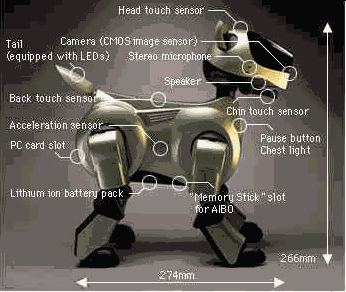
I next placed the Sony-supplied reddish pink ball under its nose. It made a doo-de-doo! football rally charge sound, carefully examined the situation with its snout-mounted 100K pixel CMOS color camera, and then earnestly smacked that ball around in amazingly novel ways. My favorite move happened when he (I had by now moved past thinking of AIBO as an "it") lowered his gaze, took a long thoughtful look at that red rubber sucker, and accomplished a complex bank shot off the side of his head. AIBO then struck an ain't-I-good animated pose and chortled in smart-aleck delight. What can I say? I was completely hooked by the end of my first AIBO experience.
He clearly had a distinctive and highly emotional personality, although AIBO did not communicate in human speech (he only made beeps and musical sounds). But after a while you figure out what he "means". I also learned that AIBO, billed by Sony as being autonomous, truly does have a mind of his own. If ignored, he might show boredom or frustration via his body language, sounds, and "eye" movements. Conversely, he would sometimes ignore me and decide to do his own thing. He also would occasionally pick himself up and spontaneously start exploring the environment, including checking himself out in highly reflective surfaces. Moreover, he continually came up with novel and surprisingly complex behaviors. It quickly became clear that Aibo was no simple beeping toy.
I next learned that if you invite people over for a party, you do not turn AIBO on unless you want the affair to come to a sudden halt. Everyone quickly gathers around the metal mutt and starts coaxing, scratching, and talking to him. They seem completely oblivious to the fact that this is an inanimate object they are interacting with. AIBO’s almost real behavior quickly makes you wonder how Sony worked its techno-magic.
Unfortunately, Sony is incredibly tightlipped about its AIBO technology, almost to the point of absurdity. Naturally, this has led to a what-makes-AIBO-tick hacker cult springing up on the Net that is determined to plumb his deep metal mysteries. If you want to maximize your AIBO experience, it’s almost mandatory you visit some of these sites.
One very informative AIBO hacker site, http://AIBOhack.com, featured a wealth of information about the complex behaviors available with the ERS-210 AIBO. Or at least the site did, until Sony shut the site's information flow off in a Draconian corporate move. For example, at one time this site had a flow chart, below, that showed how the W01 AIBOLife software will evolve from stage to stage. Other AIBO software, like ROM Demo AIBO, W02 Hello AIBO (which is almost, but not quite fully trained and is the software that came with my review unit), and W03 Party Mascot have their own personalities that are unique to the easily swapped AIBO memory sticks.
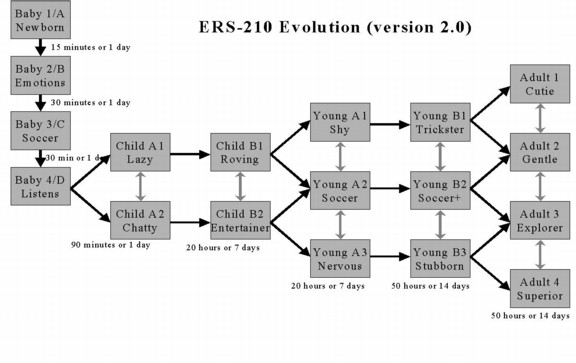
Source, http://AIBOhack.com
If it wasn't for AIBOhack.com, I would never have learned that my AIBO and its W02 software recognizes about 55 speaker independent commands, ranging from "Let’s dance!" to asking Aibo to "Karate chop!" The laughably skimpy Sony user manual had almost none of this rich user information.
A big difference between the first and second generation AIBOs is that the ERS-210 is end user programmable via PC-based software that allows the creation and editing of new behaviors. The $500 AIBO Master Studio (AMS) software lets you edit AIBO's motions, lights and sounds. Comprised of two primary functions, the Action Composer and the Behavior Arranger, AMS allows users to create and edit AIBO's behaviors through key-frame animation and then group these behaviors together to create an entirely new personality. You can incorporate a newly created behavior into a more complex program by using the Behavior Arranger to group several actions together to form a new personality. When used in conjunction with the AIBO Wireless LAN Card [ERA-201D1] you can download/transmit these new programs in real-time from up to 90 feet away. (You can also command Aibo to take a picture via its snout-mounted CMOS color camera that you can download to your PC.)
Because Sony absolutely will not disclose specific information about AIBO’s computer hardware you need to visit www.AIBOnet.com, another AIBO hacker site. At AIBOnet.com you learn that the CPU powering these complex behaviors is an RM5231A-200H made by Quantum Effect Devices (www.qedinc.com). This 200 MHz RISC chip is a MIPS IV instruction set device. This particular MIPS variant is a 64-bit chip utilizing a cost saving 32-bit external bus. On the CPU side of the board is also a custom ASIC and a 16 MB SDRAM made by a NEC. On the back of the system board is another 16 MB SDRAM and 4 megabytes of flash memory.
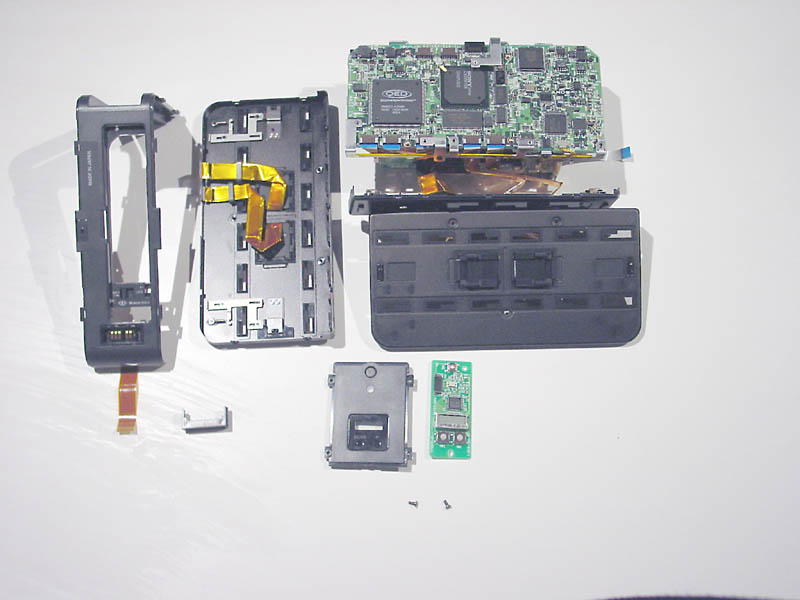
AIBO Exposed!
source, www.AIBOnet.com, an AIBO hacker site.
Of course, with a programmable robodog this capable, it took only a short while before a sternly official CERT alert appeared on the Net. This hoax alert, which was actually taken serious by some (it even showed up on www.securityfocus.com), said that AIBO needed critical patching to stop chaos bent hackers from remotely taking over your otherwise delightfully benign pet. "CERT" alarmingly warned that:
"The AttackBite () control has a serious vulnerability that allows remote intruders within earshot of AIBO to execute arbitrary code. Scripts are proliferating the Internet with new routines such as PeeOnRug (), ShoeChew (), KillTheCat () and AttackOwnersGenitals (). The latter, classified by CERT as "Denial of Service" attack, is most vicious, and for this reason CERT encourages immediate patch implementation. Some common circumstances under which this vulnerability can be exploited are addressed by the Sony patch; others are not."
CERT silliness aside (AIBO! Quit fooling around. Where did you hide my copy of "I, Robot"?), this second generation AIBO and his coming competitors’ smart interactive ilk herald a new era in personal robot technology. Conceivably, they could soon make PCs seem like ancient--and very dumb--computer history.
Japan is currently spearheading this market charge in consumer robotics. The Japanese, as any manga fan knows, are big into robots. For example, Honda http://world.honda.com/robot) recently demonstrated a remarkably humanoid robot called ASIMO that walks with a convincingly accurate and supple human gait. (To watch the streaming video on their web site is to think there is simply a man moving inside a heavy metal suit.) ASIMO can also move its head in human-like fashion as well as its hands. In one demonstration it adroitly used a wrench. In another, it shook hands with a quite trusting (or very well paid) girl. Because it was designed for home use, this highly agile robot is capable of such functions as moving through furnished rooms and going up and down stairs. The Honda design team also wanted its advanced two-foot/leg mobility technology to be compatible with most types of terrain, including very rough surfaces. ASIMO’s smooth moves are a far cry from AIBO’s rather jerky locomotion. Nor can AIBO deal with stairs or easily traverse even small obstacles that are in its way.
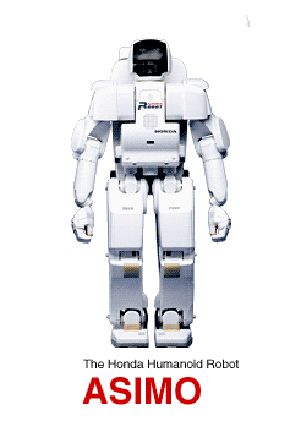
Compared with humans, the 4ft high, 100 pound ASIMO is a slow mover and for all its mass, a muscular wimp. Nor does ASIMO (V?) contain any autonomous AI breakthroughs as it is currently commanded via a human operated wireless remote control. Right now, this wannabe mechwarrior is just a big -but very agile- metal puppet. But ASIMO will inevitably be packed with off-the-shelf computer components like those used in AIBO. ASIMO will then assuredly get stuffed to overflowing with some highly sophisticated autonomous AI capabilities. The robot hacker community with its rapidly growing open software base will no doubt also join in on the ASIMO fun. (The erotic after market for the almost human scale ASIMO should prove quite interesting.)
At the other end of the size matters scale is Panasonic’s new R100 robot (www.incx.nec.co.jp/robot/English). This cute 17.3 inch high robot can recognize you with its pair of CCD video camera eyes and also greet you by name. With its three microphones, the R100 has directional hearing and will turn and look in the direction of the person who calls to it. It can also recognize different voices. It understands about 100 (still Japanese-only) phrases and can respond using a repertoire of about 300 phrases
Unlike our autonomous free range AIBO, the R100’s recognition systems are all managed and run via a remote PC using a wireless RF communication link. The PC-based R100 recognition software works in tandem with the sensors on the robot, allowing it to recognize images, faces, and voices. The R100 itself is designed around a set of core software modules that are easily expanded, modified, or enhanced. Using PC-based editing software, users can substantially enrich the functions of the R100’s sensors and the variety of its movements.
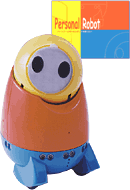
Panasonic R100
Because it is connected to your computer via a house-roaming RF link, the R100 can also act as a mobile e-mail retrieval system and will read your messages aloud, making the R100 the perfect way to have mail delivered to all you lazy couch potatoes. (With a cleverly hacked speech recognition system on your PC, you might be able to dictate your e-mail replies to the R100 as well.) The R100 also uses its umbilical PC to get instructions on how to play music and dance. But don’t worry about it crazily crashing into the china cabinet while doing a wild lambada. Via its six ultrasonic sensors, the R100 measures distances and stops instantly when something is very close or suddenly approaches from most any direction. This 17.5 pound robot also has built-in sensors that measure temperature and ambient light.
Like AIBO, if you tap, stroke or press the R100’s head, a built-in sensor accurately gauges the quality of your touch. (Good bot! Bad Bot!) Also like AIBO, it uses a variety of head motions to convey what’s on its "mind." But unlike AIBO or ASIMO, the R100 does not rely on foot locomotion to get around. Instead, it uses its three wheels to spin and move forward and backward. As long as you don’t expect it to fetch anything for you upstairs (besides your e-mail) the limb-less R100 should be able to happily move in with you. As of this writing, pricing and availability of the R100, which is still in prototype stage, have not been announced.
Given that these new generation interactive robots follow the usual off-the-cliff price/performance curve, by 2006 a slew of unbelievably smart machines costing less than $100 should be arriving on the scene. If my experience with AIBO is any measure, most people will quickly forget these are inanimate objects that they are intelligently -and emotionally- interacting with. But does inanimate also mean non-sentient? I have the very strong (and admittedly creepy feeling) that by 2010, if not sooner, these little, and some not so little, blinking, beeping, hearing, seeing, walking, talking consumer critters may quickly evolve into a surprising new life form. At that point, a whole new debate will most likely begin about "robot rights."
Come decade’s end, mankind’s secure position at the top of the food chain could abruptly end not with an almighty bang, but with a tuneful beep-beep.
Copyright 2001 Franco Vitaliano, All Rights Reserved
21st, The VXM Network, https://vxm.com